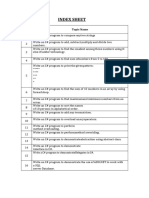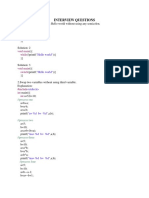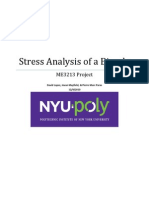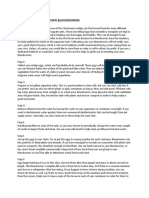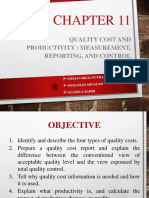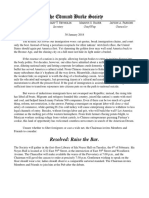Department of Computing: Lab Topic: For Loop
Department of Computing: Lab Topic: For Loop
Uploaded by
Hamid MuzaffarCopyright:
Available Formats
Department of Computing: Lab Topic: For Loop
Department of Computing: Lab Topic: For Loop
Uploaded by
Hamid MuzaffarOriginal Title
Copyright
Available Formats
Share this document
Did you find this document useful?
Is this content inappropriate?
Copyright:
Available Formats
Department of Computing: Lab Topic: For Loop
Department of Computing: Lab Topic: For Loop
Uploaded by
Hamid MuzaffarCopyright:
Available Formats
Department of Computing
CS110: Fundamentals of Computer Programming
Lab Topic: for loop
CLO1: Understand the syntax and semantics of different programming
constructs
Instructor: Mr. Jaudat Mamoon
Lab Engineer: ---
CS110: Fundamentals of Computer Programming Page 1
Lab: for loop
Introduction
The purpose of this lab is to get familiar with usage of for loop in C programming.
Objectives
The objective of this lab is to design solution using while loop.
Tools/Software Requirement
MS Visual Studio
Description
A for loop is a repetition control structure that allows you to efficiently write a loop that needs to
execute a specific number of times.
Syntax
The syntax of a for loop in C programming language is –
for ( init; condition; increment ) {
statement(s);
}
Here is the flow of control in a 'for' loop −
The init step is executed first, and only once. This step allows you to declare and
initialize any loop control variables. You are not required to put a statement here, as
long as a semicolon appears.
Next, the condition is evaluated. If it is true, the body of the loop is executed. If it is
false, the body of the loop does not execute and the flow of control jumps to the next
statement just after the 'for' loop.
After the body of the 'for' loop executes, the flow of control jumps back up to
the increment statement. This statement allows you to update any loop control
variables. This statement can be left blank, as long as a semicolon appears after the
condition.
CS110: Fundamentals of Computer Programming Page 2
The condition is now evaluated again. If it is true, the loop executes and the process
repeats itself (body of loop, then increment step, and then again condition). After the
condition becomes false, the 'for' loop terminates.
Flow Diagram
Example
#include <stdio.h>
int main () {
int a;
/* for loop execution */
for( a = 10; a < 20; a = a + 1 ){
printf("value of a: %d\n", a);
}
CS110: Fundamentals of Computer Programming Page 3
return 0;
}
When the above code is compiled and executed, it produces the following result −
value of a: 10
value of a: 11
value of a: 12
value of a: 13
value of a: 14
value of a: 15
value of a: 16
value of a: 17
value of a: 18
value of a: 19
Lab Tasks:
Using for loops, unless specified otherwise, perform the following tasks.
1. (Printing the Decimal Equivalent of a Binary Number) Input an integer containing only0s and 1s
(i.e., a “binary” integer) and print its decimal equivalent. [Hint: Use the remainder and division
operators to pick off the “binary” number’s digits one at a time from right to left. Just as in the
decimal number system, in which the rightmost digit has a positional value of 1, and the next
digit left has a positional value of 10, then 100, then 1000, and so on, in the binary number
system the rightmost digit has a positional value of 1, the next digit left has a positional value of
2, then 4, then 8, and so on. Thus the decimal number 234 can be described as 4 * 1 + 3 * 10 + 2
* 100.The decimal equivalent of binary 1101 is 1 * 1 + 0 * 2 + 1 * 4 + 1 * 8 or 1 + 0 + 4 + 8 or 13.]
2. (How Fast is Your Computer?) How can you determine how fast your own computer really
operates? Write a program with a for loop that counts from 1 to 300,000,000 by 1s. Every
time the count reaches a multiple of 100,000,000, print that number on the screen. Use your
watch to time how long each 100 million repetitions of the loop takes .
CS110: Fundamentals of Computer Programming Page 4
3. (Calculating the Value of π) Calculate the value of πfrom the infinite series.
π = 4 - 4/3 + 4/5 - 4/7 + 4/9 - 4/11 +…
Print a table that shows the value of πapproximated by one term of this series, by two terms, by three terms, and
so on. How many terms of this series do you have to use before you first get 3.14?3.141? 3.1415? 3.14159?
4. Write a program that prints the following patterns separately one below the other. All asterisks
(*) should be printed by a single printf statement of the form printf( "*" ).[Hint: The
last two patterns require that each line begin with an appropriate number of blanks.]
CS110: Fundamentals of Computer Programming Page 5
Task # 1(Code):
//Hamid Muzaffar Khan
//CMS ID : 356209
//BS-CS 10-B
#include<stdio.h>
int main()
{
//This program is for any number of binary digit
int binary, base = 1, decimal = 0, digit;//binary is used to enter binary number
printf("Enter a binary number = ");
scanf_s("%d", &binary);
for (; binary >= 1;)//loop runs until binary number become zero
{
digit = binary % 10;//carry last gigit of binary
decimal = decimal + (digit * base);
binary = binary / 10;//eliminates last digit of binary
base = base * 2;//base increses by 2 in each cylcle according to number of
digit eliminmates in the next cylce
}
printf("Decimal conversion of binary is %d\n", decimal);
return 0;
}
Output:
CS110: Fundamentals of Computer Programming Page 6
Task # 2(Code):
Method 1
//Hamid Muzaffar Khan
//CMS ID : 356209
//BS-CS 10-B
#include<stdio.h>
int main()
{
int count;
for (count = 1; count <= 300000000; count++)
{
if (count == 100000000)//when count is 100000000 then it prints "Multiple
is 1"
printf("Multiple is 1\n");
else if (count == 200000000)//when count is 200000000 then it prints
"Multiple is 2"
printf("Multiple is 2\n");
else if (count == 300000000)//when count is 300000000 then it prints
"Multiple is 3"
printf("Multiple is 3\n");
}
//By calculating execution time and then divide it by three we can calculate the
time in which it counts 100000000
return 0;
}
Method 2
//Hamid Muzaffar Khan
//CMS ID : 356209
CS110: Fundamentals of Computer Programming Page 7
//BS-CS 10-B
#include<stdio.h>
int main()
{
int count;
for (count = 1; count <= 100000000; count++)//count to 100000000
{
}
printf("Multiple is 1\n");//when count is 100000000 then it prints given statement
for (; count <= 200000000; count++)//count to 200000000
{
}
printf("Multiple is 2\n");//when count is 200000000 then it prints given statement
for (count = 1; count <= 300000000; count++)//count to 300000000
{
}
printf("Multiple is 3\n");//when count is 300000000 then it prints given statement
return 0;
}
Output:
My computer counts 300000000 in 1.12sec so it counts 100000000 in 0.3733sec.
Task # 4(Code):
CS110: Fundamentals of Computer Programming Page 8
//Hamid Muzaffar Khan
//CMS ID : 356209
//BS-CS 10-B
#include<stdio.h>
int main()
{
//count_row is used for indicating row and count_column is used for column.
int count_col, count_row, gap;//gap is used for shape 3 and 4
for (count_row = 10; count_row >= 1; count_row--)//This loop is for shape 1.
{
for (count_col = 10; count_col >= count_row; count_col--)
{
printf("*");
}
printf("\n");
}
printf("\n");
for (count_row = 1; count_row <= 10; count_row++)//This loop is for shape 2
{
for (count_col = 10; count_col >= count_row; count_col--)
{
printf("*");
}
printf("\n");
}
printf("\n");
for (count_row = 1; count_row <= 10; count_row++)//This loop is for shape 3
{
for (count_col = 10; count_col >= count_row; count_col--)
{
printf("*");
}
printf("\n");
for (gap = 0; gap<count_row; gap++)
{
printf(" ");
}
}
printf("\n");
for (count_row = 10; count_row >= 1; count_row--)//This loop is for shape 4
{
for (gap = 1; gap <= count_row; gap++)
{
printf(" ");
}
for (count_col = 10; count_col >= count_row; count_col--)
{
printf("*");
}
printf("\n");
}
return 0;
}
CS110: Fundamentals of Computer Programming Page 9
Output:
Task # 3(Code):
//Hamid Muzaffar Khan
//BS-CS 10-B
CS110: Fundamentals of Computer Programming Page 10
//CMS = 356209
#include <stdio.h>
int main()
{
int count, i = 1;
double p = 0, l;
printf("Term pi\n");
for (count = 1; count <= 400000; count++)
{
l = (double)4 / i;
if (count % 2 == 0)//Count represent position number If position number is
even then it substract otherwise adds
{
p = p - l;
}
else
{
p = p + l;
}
i = i + 2;
printf("%d %f\n", count, p);
if (count == 119 || count == 1690 || count == 10736 || count ==
146063)//when count reaches any of these number then program stops and ask for some
character to continue
getchar();
}
return 0;
}
Output:
CS110: Fundamentals of Computer Programming Page 11
CS110: Fundamentals of Computer Programming Page 12
CS110: Fundamentals of Computer Programming Page 13
Result:
I got 3.14 at 119.
I got 3.141 at 1690.
I got 3.1415 at 10736.
I got 3.14159 at 146063.
CS110: Fundamentals of Computer Programming Page 14
You might also like
- Write A C Program That Receives 10 Float Numbers From The Console and Sort Them in Nonascending Order, and Prints The ResultDocument36 pagesWrite A C Program That Receives 10 Float Numbers From The Console and Sort Them in Nonascending Order, and Prints The ResultAzeemNo ratings yet
- Department of Computing: CLO1: Understand The Syntax and Semantics of Different Programming ConstructsDocument14 pagesDepartment of Computing: CLO1: Understand The Syntax and Semantics of Different Programming ConstructsHamid MuzaffarNo ratings yet
- C ProgramDocument14 pagesC Programsreelakshmif06No ratings yet
- C# Programming Lab ManualDocument25 pagesC# Programming Lab Manualvinaykumarms343No ratings yet
- Programming Fundamentals WholeDocument15 pagesProgramming Fundamentals Wholesajalay17No ratings yet
- C Programming - B PartDocument19 pagesC Programming - B PartPriya JoyNo ratings yet
- C ProgramsDocument7 pagesC ProgramsRubini RavichandranNo ratings yet
- Review Questions I Key Spring 2010Document8 pagesReview Questions I Key Spring 2010Emmanuel NwankwoNo ratings yet
- Lab Task Ralated To For Loop SolutionDocument12 pagesLab Task Ralated To For Loop SolutionMudasirNo ratings yet
- C How To Program 14Document22 pagesC How To Program 14alinaNo ratings yet
- Short Answers PPSDocument72 pagesShort Answers PPSKasabu Nikhil GoudNo ratings yet
- Top 100 Programs Part 2Document45 pagesTop 100 Programs Part 2M. JeevamukeshNo ratings yet
- Solutions Midterm 1 March 72020Document7 pagesSolutions Midterm 1 March 72020Arpita 18No ratings yet
- C Programs NewComputer Programming Subject Notes. Subject Code : GE6151 Anna UniversityDocument4 pagesC Programs NewComputer Programming Subject Notes. Subject Code : GE6151 Anna UniversitysurendiranNo ratings yet
- A Short Guide To Written Exam C Output ProblemDocument16 pagesA Short Guide To Written Exam C Output ProblemMd. EmdadNo ratings yet
- C Program SolutionDocument8 pagesC Program Solutionbdserver2407No ratings yet
- C ProgrammingDocument22 pagesC ProgrammingGaneshanNo ratings yet
- WAP To Find The Sum of The Series S 1 + (3/2!) + (5/3!) + (7/4!) + ....... To NDocument8 pagesWAP To Find The Sum of The Series S 1 + (3/2!) + (5/3!) + (7/4!) + ....... To NSOUMYA MAHAPATRANo ratings yet
- Write A Program To Display The Multiplication Table of A Given NumberDocument21 pagesWrite A Program To Display The Multiplication Table of A Given Numberjndivya100% (1)
- Break Continue GotoDocument8 pagesBreak Continue GotoConnie BaelloNo ratings yet
- Lab#4Document7 pagesLab#4zainabsaleem2004444No ratings yet
- Ekt120 Week06 Functions2Document25 pagesEkt120 Week06 Functions2Muhammad Faiz bin Ahmad ShafiNo ratings yet
- 1) How To Print Below Pattern?Document28 pages1) How To Print Below Pattern?Mansi DixitNo ratings yet
- For Loop ES081 PART BDocument21 pagesFor Loop ES081 PART BDavid AlingasaNo ratings yet
- C Programming Complete Lab 1-17Document41 pagesC Programming Complete Lab 1-17MURALI KARTHIK REDDYNo ratings yet
- C-Lab ManualDocument59 pagesC-Lab ManualAaron GurramNo ratings yet
- Control Statements:: Program To Find The Largest Number Between Two Numbers Using Switch CaseDocument23 pagesControl Statements:: Program To Find The Largest Number Between Two Numbers Using Switch CaseIrene SultanaNo ratings yet
- Chapter 11: Iterative StatementDocument24 pagesChapter 11: Iterative StatementMap ayatNo ratings yet
- Dot NeT TechnologyDocument36 pagesDot NeT TechnologyPrijan KhadNo ratings yet
- C Test:: What Is The Output ? Main (Int I 5 If (I 5) (I 100 Printf (" %D ",i) ) ) A. 100Document17 pagesC Test:: What Is The Output ? Main (Int I 5 If (I 5) (I 100 Printf (" %D ",i) ) ) A. 100Beena WalvekarNo ratings yet
- Taylor SeriesDocument6 pagesTaylor SeriesAtharva SinghNo ratings yet
- Assignments Sem 1Document98 pagesAssignments Sem 1Argho GhoshNo ratings yet
- C TestDocument17 pagesC TestVishnu VandanaNo ratings yet
- 21CS21Document26 pages21CS21anvithaathreyasNo ratings yet
- Review Questions I KeyDocument9 pagesReview Questions I Keymulokoziavitha9No ratings yet
- QuesDocument8 pagesQuesGL SOFTWARENo ratings yet
- Steeve Assignment II (Intro To Programming)Document13 pagesSteeve Assignment II (Intro To Programming)benialsteeveNo ratings yet
- BSCS CC-112 PF 2022 SolvedDocument8 pagesBSCS CC-112 PF 2022 Solvedanamkhurshid1730No ratings yet
- Iterative StatementsDocument14 pagesIterative Statementssavagegamer1289No ratings yet
- C Programming MCQDocument206 pagesC Programming MCQBikram DeNo ratings yet
- C++ ProgramsDocument52 pagesC++ ProgramsNARAYANANNo ratings yet
- Lab Session 3Document6 pagesLab Session 3Ali YazdaniNo ratings yet
- PPC Lab3Document7 pagesPPC Lab31ayusharun1No ratings yet
- C Interview QuestionsDocument22 pagesC Interview Questionsprince malhotraNo ratings yet
- LoopsDocument7 pagesLoopsusoul683No ratings yet
- CBSE Class XI Computer Science NotesDocument31 pagesCBSE Class XI Computer Science NotesdeltaserrapapaNo ratings yet
- Arithmetic Operators and Basic I/O: You Can Add Two Numbers With A Plus SignDocument11 pagesArithmetic Operators and Basic I/O: You Can Add Two Numbers With A Plus SignaloutolentinoNo ratings yet
- C# Manual Draft (Ise)Document20 pagesC# Manual Draft (Ise)Abhishes SahNo ratings yet
- Lecture - 2 (Python) E-NotesDocument16 pagesLecture - 2 (Python) E-NotesabyefinalhaiNo ratings yet
- Looping / Iterative Statements: While LoopDocument7 pagesLooping / Iterative Statements: While LoopDark AngelNo ratings yet
- Unit 2-2 MarksDocument10 pagesUnit 2-2 Marksviperdeva8No ratings yet
- C QuestionDocument17 pagesC QuestionCincy AjiNo ratings yet
- C ProgramingDocument7 pagesC ProgramingSantosh Kumar SharmaNo ratings yet
- 2010 Spring Midterm1 SolutionsDocument9 pages2010 Spring Midterm1 SolutionsPoyrazNo ratings yet
- NumbersDocument6 pagesNumbersapi-284283149No ratings yet
- PDC Lab 9 FinalDocument21 pagesPDC Lab 9 Finalkartikshettiwar2004No ratings yet
- 10seconds CDocument186 pages10seconds CNithin MurthyNo ratings yet
- Week 6 10Document44 pagesWeek 6 10Aditya RajNo ratings yet
- Bicycle Design ProjectDocument12 pagesBicycle Design Projectjabirp27No ratings yet
- BCIS 1405 Powerpoint Session 11Document39 pagesBCIS 1405 Powerpoint Session 11Anonymous 8iQCVo2No ratings yet
- How To Breed BloodwormsDocument2 pagesHow To Breed Bloodwormsmich pdNo ratings yet
- Income InequalityDocument20 pagesIncome Inequalitymarve_gamboa1006No ratings yet
- Monterrosa 2019Document18 pagesMonterrosa 2019GERARDO TORRES RUIZNo ratings yet
- EmporiumDocument11 pagesEmporiumNabeera Ali NaqviNo ratings yet
- Auto CadDocument8 pagesAuto CadFuyis FaresNo ratings yet
- Kelompok 5 Quality CostDocument36 pagesKelompok 5 Quality CostMuhamad ArnaldoNo ratings yet
- MESAB Profile (Shortversion)Document18 pagesMESAB Profile (Shortversion)Tat ThuanNo ratings yet
- CRP Proforma InvoiceDocument2 pagesCRP Proforma Invoicevishi2219No ratings yet
- Computer Fundamentals Solved MCQs (Set-1)Document8 pagesComputer Fundamentals Solved MCQs (Set-1)Buxar Students LifeNo ratings yet
- Sea Bed Logging (SBL), A New Method For Remote and Direct Identification of Hydrocarbon Filled Layers in Deepwater AreasDocument9 pagesSea Bed Logging (SBL), A New Method For Remote and Direct Identification of Hydrocarbon Filled Layers in Deepwater AreasCarlos Rafael Lizarraga ArreolaNo ratings yet
- Edmund Burke Maroon 2/4/18Document1 pageEdmund Burke Maroon 2/4/18Chicago MaroonNo ratings yet
- Knapsack LectDocument17 pagesKnapsack Lectazeemahmad570No ratings yet
- Jteft 04 00139Document8 pagesJteft 04 00139Momtaz Islam SobujNo ratings yet
- Analysis of Fabrcation Methods For MGs Based Composites - A ReviewDocument8 pagesAnalysis of Fabrcation Methods For MGs Based Composites - A ReviewVivek ChawlaNo ratings yet
- 5 Joint Probability Distribution.7245.1583725420.9784Document30 pages5 Joint Probability Distribution.7245.1583725420.9784Pun AditepNo ratings yet
- Resistancepropulsion ExercisesDocument22 pagesResistancepropulsion ExercisesRachel Erica Guillero BuesingNo ratings yet
- Mechatest Steam Sample Conditioning - LPMTDocument2 pagesMechatest Steam Sample Conditioning - LPMTGuerreros TerrandinaNo ratings yet
- List of Melaka CompaniesDocument3 pagesList of Melaka CompaniesNasrul SalmanNo ratings yet
- Request For Relevant MaterialDocument1 pageRequest For Relevant Materialsandra kivedoNo ratings yet
- Basics of Nonlinear Pushover AnalysisDocument3 pagesBasics of Nonlinear Pushover AnalysisRafiqulIslamNo ratings yet
- 13.8 V 15 A From A PC Power SupplyDocument8 pages13.8 V 15 A From A PC Power SupplyTibor NemethNo ratings yet
- TLE2061 PrecisionDocument82 pagesTLE2061 PrecisionvelizarkoNo ratings yet
- 2019 ELT Oxford University Germany and Australia CatalogueDocument9 pages2019 ELT Oxford University Germany and Australia CatalogueJuan Jose AvilaNo ratings yet
- PE GuideDocument3 pagesPE GuideJuan Diego Vasquez BeraunNo ratings yet
- Soft X-Ray Optics (Eberhard - Spiller)Document291 pagesSoft X-Ray Optics (Eberhard - Spiller)utente489133No ratings yet
- Pol Science David EastonDocument4 pagesPol Science David EastonKrish KalroNo ratings yet
- Gassification For Practical ApplicationsDocument350 pagesGassification For Practical ApplicationshugogalindoNo ratings yet
- Defense Motion To Dismiss CaseDocument44 pagesDefense Motion To Dismiss CaseavertebrateNo ratings yet




























